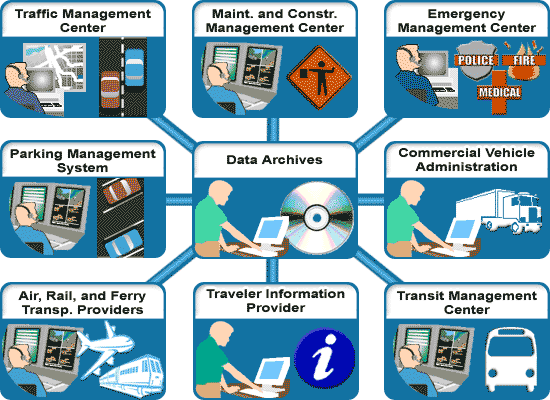Application Areas
Data Archival
Description
This center-to-center application area covers the interface between a transportation data archive and the sources of the archived data. It also covers the interface between the data archive and users of the archived data. An ITS data archive collects and maintains data to be used for planning, analysis, operations, and research. The data placed into the archive can come from a variety of transportation systems including traffic management centers, transit management centers, emissions management systems, emergency management centers, commercial vehicle administration systems, transportation asset systems, maintenance and construction management systems, traveler information providers, providers of other modes of transportation (e.g. rail, ferry, or air), parking systems, toll systems, and intermodal freight carriers or terminals. The data archive may also include data that is not collected by transportation systems (e.g., weather information). The users of the archive data include various user systems as well as other data archives.
National ITS Architecture Interface
This application area centers around the Archived Data Management Subsystem (ADMS), which gathers information about surface transportation for later analysis. There are many subsystems and terminators in the National ITS Architecture that provide data to the ADMS. Each of these interfaces operate in a similar fashion. The ADMS can request a catalog of the transportation data and/or the data itself from each data source. Each data source provides metadata (data about the data; e.g. source and time when the data was collected) as well as the data itself to enable validation and off line analysis of the data. The ADMS in turn provides status (indicating whether the received data was valid and received without error) to the data source. The data source interfaces to the ADMS include: <ul> <li>The Traffic Management Subsystem provides current, predicted, and historical traffic data, as well as video images and operational data to the ADMS.</li> <li>The Transit Management Subsystem provides transit passenger data, transit deployment data, transit user payment data, transit emergency, security, maintenance and personnel data. <li>The Emissions Management Subsystem provides information on air quality and vehicle emissions data.</li> <li>The Emergency Management Subsystem provides information on incidents, evacuations, alerts and advisories, resource information, and threat data.</li> <li>The Maintenance and Construction Management Subsystem provides information describing road construction and maintenance activities.</li> <li>The Information Service Provider sends data associated with traveler information services including service requests and confirmations (e.g., trip requests, route requests, yellow pages services requests, ridesharing requests, parking requests), vehicle probe data, route guidance data, and other route usage data (e.g., cycling, walking).</li> </ul> Consult the National ITS Architecture for a complete list of centers that provide information to the ADMS. Data can also be shared with other data archives. The archived data in the ADMS may be accessed by users (Archived Data User Systems). Users can request and received archived data products (i.e. data, meta data, or data catalogs) or request on-line processing and analyses of the archived data.Applicable Standards
In general, the following standards are applicable to Data Archival deployments. To determine which specific standards are applicable for a deployment you will need to determine which architecture flows will be needed for the Data Archival piece of your deployment. Contact your local FHWA ITS Division Specialist or an ITS Standards Program Field Support Team contact
Deployment Resources
Deployment resources can be found in the deployment resources
section.
- NTCIP Case study reports (1999-2004)
- ADUS (Archived Data User Service) Standards Advisory
- IM (Incident Management) Standards Advisory
- NTCIP 9010 — XML in ITS Center-to-Center Communications